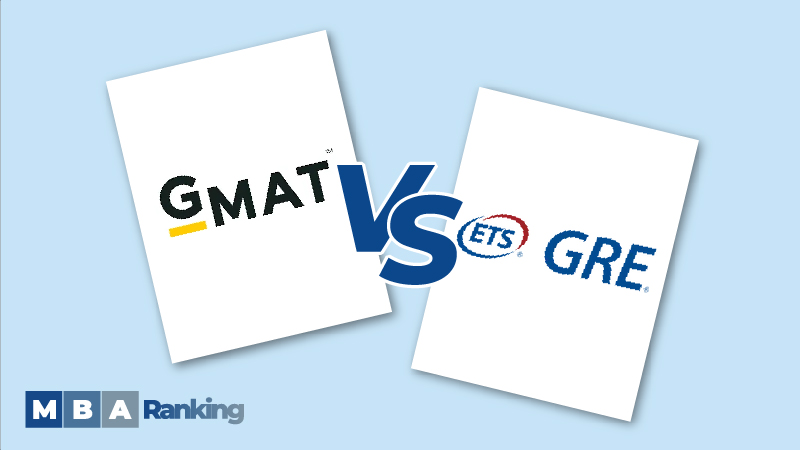GMAT vs. GRE? What’s best for your MBA applications?

Increasingly MBA schools take GRE as a substitute test of GMAT. Though GMAT has been the most widely accepted standardized score for MBA applications, given the little variations between the two tests, MBA schools now see GRE can be a suitable alternative. Then, are the really different? By how much?
GMAT vs. GRE
The GMAT (Graduate Management Admission Test) and GRE (Graduate Record Examination) are both standardized tests that are often required for admission to graduate programs, particularly in the United States. While they serve a similar purpose, there are some key differences between the two exams:
- Purpose and Focus:
- GMAT: The GMAT is primarily used for admission to business school programs, such as MBA (Master of Business Administration) programs. It focuses on assessing analytical writing, integrated reasoning, quantitative reasoning, and verbal reasoning skills that are relevant to business and management education.
- GRE: The GRE is a more generalized exam used for admission to a wide range of graduate programs, including business, arts and sciences, engineering, and other fields. It evaluates analytical writing, verbal reasoning, and quantitative reasoning skills, but with a broader focus compared to the GMAT.
- Sections and Structure:
- GMAT: The GMAT consists of four sections: Analytical Writing Assessment (AWA), Integrated Reasoning (IR), Quantitative Reasoning (QR), and Verbal Reasoning (VR). The AWA section requires test takers to write an essay, while the other three sections are multiple-choice questions.
- GRE: The GRE consists of three sections: Analytical Writing, Verbal Reasoning, and Quantitative Reasoning. There is also an optional fourth section, the Research section, which is unscored and used for research purposes only. The Analytical Writing section requires test takers to write two essays, and the remaining sections are a mix of multiple-choice and select-all-that-apply questions.
- Question Types:
- GMAT: The GMAT includes specific question types such as data sufficiency in the quantitative section and critical reasoning in the verbal section. It also has a section on integrated reasoning, which assesses the ability to analyze and synthesize information from different sources.
- GRE: The GRE has a broader range of question types, including text completion, sentence equivalence, and reading comprehension in the verbal section, and quantitative comparison, data interpretation, and problem-solving in the quantitative section.
- Score Scales:
- GMAT: The GMAT score range is from 200 to 800 for the quantitative and verbal sections, with a separate score for the AWA section ranging from 0 to 6.
- GRE: The GRE score range is from 130 to 170 for the verbal and quantitative sections, with a separate score for the Analytical Writing section ranging from 0 to 6.
It’s important to note that while the GMAT is primarily associated with business schools and the GRE is more commonly used for other graduate programs, many business schools now accept both exams. It’s recommended to check the specific requirements of the programs you are interested in to determine which test they accept.
Why business schools start taking GRE?
Business schools have started accepting the GRE in addition to the GMAT for several reasons:
- Diversifying Applicant Pool: Accepting the GRE allows business schools to attract a broader range of applicants. The GRE is a more generalized test that is taken by students applying to a wide variety of graduate programs, not just business schools. By accepting the GRE, business schools can tap into a larger pool of candidates with diverse educational backgrounds and interests.
- Adapting to Changing Trends: The GRE has gained popularity in recent years as an alternative to the GMAT. Many prospective students who are considering both business and non-business graduate programs choose to take the GRE to keep their options open. Business schools recognize this trend and want to ensure that they don’t miss out on highly qualified candidates who have taken the GRE.
- Assessing Different Skill Sets: The GMAT and GRE assess slightly different skill sets. While the GMAT is designed specifically to measure skills relevant to business and management education, the GRE evaluates broader analytical and critical thinking abilities. Business schools recognize that successful business leaders need a range of skills beyond just business knowledge, such as strong communication, problem-solving, and critical thinking abilities. By accepting the GRE, schools can evaluate applicants based on a wider skill set.
- Rankings and Competitiveness: Business schools often strive to improve their rankings and attract the best students. Accepting the GRE allows schools to compete for top talent with other programs that accept the GRE, including non-business graduate programs. It also provides an opportunity for schools to differentiate themselves and showcase their flexibility in admissions requirements.
- Access and Inclusivity: Accepting the GRE can help promote access and inclusivity in business education. Some prospective students may face financial constraints or have limited access to GMAT preparation resources. By accepting the GRE, business schools can create a more accessible pathway for these individuals to pursue a business education.
It’s important to note that while many business schools accept the GRE, some may still have a preference for the GMAT or may have specific requirements for applicants who submit GRE scores. It’s advisable to research the individual requirements of the business schools you are interested in to ensure you are well-prepared for the application process.
Is it easier to earn higher score in GRE?
It’s challenging to determine whether it is easier to earn a higher score on the GRE compared to the GMAT because the difficulty level and content of the exams vary. However, I can provide some insights regarding the scoring scales and the perception of difficulty:
- Scoring Scales: Both the GRE and GMAT use different scoring scales, which can make direct comparisons challenging. The GRE uses a score range of 130-170 for the verbal and quantitative sections, while the GMAT uses a range of 200-800 for the verbal and quantitative sections. It’s worth noting that both exams use adaptive scoring algorithms, meaning the difficulty of subsequent questions is influenced by your performance on previous questions.
- Subjective Perception: The perception of difficulty may vary from person to person. Some test-takers may find the GRE more manageable due to their strengths in verbal and analytical skills, while others may find the GMAT more approachable if they have a strong foundation in quantitative reasoning. It ultimately depends on your individual strengths and weaknesses.
- Preparation and Familiarity: Success on either exam is highly dependent on the time and effort you invest in preparation. Familiarizing yourself with the question formats, content areas, and test-taking strategies specific to each exam can significantly improve your performance. Your preparation and level of familiarity with the exam will play a crucial role in your ability to earn a higher score.
- Program Requirements: When deciding which exam to take, it’s important to consider the specific requirements of the programs you are applying to. Some programs may have a preference for the GMAT, while others accept both the GRE and GMAT equally. Researching the preferences of your target programs can help inform your decision and guide your preparation efforts.
Ultimately, the difficulty of earning a higher score depends on various factors, including your strengths, preparation, and familiarity with the exam. It’s essential to develop a study plan, utilize appropriate resources, and practice extensively to achieve your desired score, regardless of whether you choose the GRE or GMAT.






